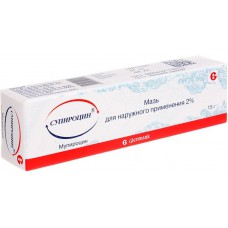Expiration date: 08/2026
Composition
100 g of ointment contains:
Active substance: mupirocin - 2 g.
Auxiliary substances: macrogol 400 (polyethylene glycol 400), macrogol 4000 (polyethylene glycol 4000).
Dosage form
Ointment for external use.
Description
A homogeneous ointment of white color.
Pharmacodynamics
Mupirocin is an antibiotic produced by the Pseudomonas fluorescens microorganism. Mupirocin suppresses bacterial cell protein synthesis by reversible binding to isoleucyl-transport RNA synthetase, which prevents the incorporation of isoleukin into protein chains under construction. When used in minimal inhibitory concentrations, mupirocin has a bacteriostatic, and in higher concentrations, a bactericidal effect.
Due to the specific mechanism of action and unique chemical structure, there is no cross-resistance with other antibiotics.
With proper use of mupirocin, the risk of resistant strains of microorganisms is low.
Spectrum of antibacterial activity in vitro:
Gram-positive aerobes:
- Staphylococcus aureus (including strains resistant to methicillin and producing beta-lactamases),
- Staphylococcus epidermidis,
- Staphylococcus species,
- Coagulase-Negative Staphylococcus,
- Gram-negative anaerobes:
- Haemophilus influenzae,
- Neisseria gonorrhoeae,
- Neisseria meningitidis,
- Branhamella catarrhalis,
- Pasteurella multocida,
- Proteus mirabilis,
- Proteus vulgaris,
- Enterobacter cloacae,
- Enterobacter aerogenes,
- Citrobacter freundii,
- Bordetella pertussis
Insensitive:
- Corynebacterium species,
- Enterobacteriaceae,
- Gram-negative non-fermenting sticks,
- Micrococcus.
Pharmacokinetics
Mupirocin practically does not penetrate through intact skin. In the case of adsorption through damaged skin, it is metabolized to a microbiologically inactive metabolite, monic acid, and is rapidly excreted by the kidneys.
Indications for use
Primary and secondary infectious skin lesions caused by microorganisms sensitive to mupirocin, including:
- primary skin infections:
- impetigo,
- folliculitis,
- furunculosis (including boils of the external auditory canal and auricle),
- ecthyma,
- secondary infections:
- infected eczema,
- infected injuries (abrasions, insect bites, wounds, burns).
Contraindications
There is no data available.
Use during pregnancy and lactation
Currently, there is insufficient data on the use of mupirocin during pregnancy, so the use of the drug is possible if the expected benefit exceeds the possible risk of complications.
Excretion of the drug into breast milk is unlikely, however, the use of the drug during lactation is possible if the expected benefit exceeds the possible risk of complications.
Side effects
Supirocin ointment is well tolerated.
Very rarely, burning and itching are observed at the site of application of the drug.
In less than 1% of cases, erythema, dry skin, OTC, and contact dermatitis may occur.
Allergic skin reactions (swelling at the application site, rash) to mupirocin or the base of the ointment were rarely observed. Generalized allergic reactions have been reported in isolated cases when using Supirocin ointment.
Interaction
Not reported.
Supirocin ointment cannot be combined with other topical preparations due to the risk of dilution, which is manifested by a decrease in antibacterial activity and a potential loss of stability.
Method of administration and dosage
A small amount of mupirocin is applied to the affected skin surface. A bandage can be applied on top.
After applying the drug to the skin, wash your hands thoroughly.
Apply 2-3 times a day for up to 10 days, depending on the severity of the lesion.
In the absence of a clinical effect within 3-5 days, it is recommended to review the diagnosis and treatment tactics.
Impaired liver function
No correction is required.
Impaired renal function
See the section With caution.
Elderly patients: no restrictions required. Also see the section With caution.
Overdose
There is no data available.
Special instructions
Do not apply on mucous membranes or in the drainage area. Avoid getting the ointment in the eyes. In case of contact, rinse thoroughly with water until the remaining ointment is completely removed.
In rare cases of allergic reactions or significant irritation of the skin when using Supirocin ointment, treatment should be discontinued, the affected area should be rinsed with water to remove the remnants of the ointment and alternative antibacterial therapy should be prescribed.
As with other antibacterial drugs, prolonged administration of Supirocin ointment can lead to excessive growth of insensitive microorganisms.
Influence on the ability to drive motor vehicles and manage mechanisms
There was no adverse effect on the ability to drive a car / mechanisms.
Form of release
Ointment for topical and external use, 2%.
Storage conditions
In a dry place protected from light, at a temperature not exceeding 25 C. Do not freeze.
Keep out of reach of children.
Expiration date
2 years. Do not use after the expiration date.


